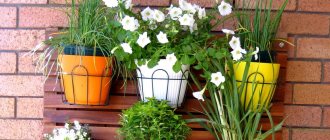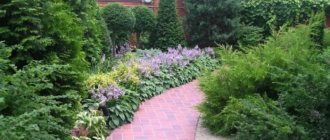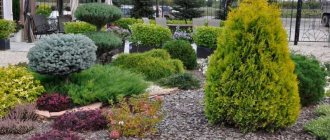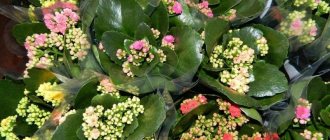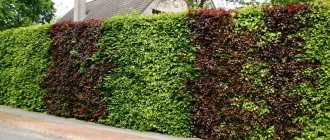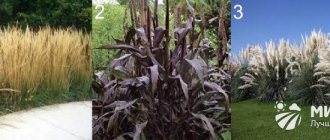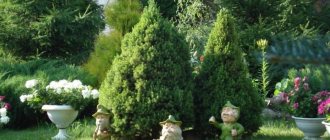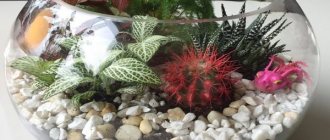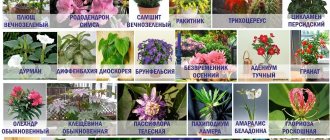About planning a summer cottage
When deciding on a garden design option, you need to decide in advance what you want to see as a result, only after that you can start choosing and purchasing plants. After dividing the territory, you can begin planting them according to the drawn up project.
When choosing plants, you should pay attention to the following points:
- duration and timing of flowering;
- the height of the bush and the area it will occupy;
- plant lifespan;
- frost resistance indicators of the variety;
- requirement for care.
The composition and quality of the soil on the site can also influence the choice of plants. Naturally, all selected plants must correspond to the style in which it is planned to decorate the garden.
Let's proceed to a direct examination of the characteristics of the most popular plants.
We invite you to watch a useful video on how to properly plan a site and what ornamental shrubs to plant on it:
Spirea
Spirea
After winter, you want to admire beautiful flowers as early as possible, so early flowering crops are of interest. The leader in this group is spirea.
The plant is divided into two types: summer-flowering and spring-flowering. Summer varieties have pink and lilac buds, and spring varieties have white buds.
The flowering period occurs in the first days of May; it can last until the end of June, or even until mid-July.
Some varieties of spirea, under favorable weather conditions, can re-bloom in the fall.
Features and Specifications:
- easy to care for, grows on all types of soil;
- the height of the bushes can vary significantly; there are varieties that are short (up to fifty centimeters) and tall (up to two and a half meters);
- has high frost resistance;
- characterized by long-lasting abundant flowering;
- grows quickly;
- is an excellent honey plant;
- actively develops and blooms in sunny areas and in partial shade.
Dicentra
Dicentra is known to many as a flower with the name “broken heart”. Among gardeners, the most popular type is Dicentra splendid. No special care is required for the bush, but periodically it is necessary to trim the peduncles and shoots. Any soil can be used for planting - the flower will take root anywhere.
Externally, the dicentra is a lush bush, the height of which is up to 60 cm. One of the advantages of the flower is its durability: it can not be replanted for up to 8 years.
Flowering is presented in the form of long, elegant pink oblate-heart-shaped flowers, the diameter of which is about 2 cm. The plant blooms throughout May, but sometimes the period can shift, depending on the air temperature.
If you want the plant to please you with flowering at the end of the summer season, it is recommended to cut off the old stems at the end of May, leaving a few young leaves.
Dicentra can be planted in sunny areas and in the shade, as it adapts to any conditions.
Important! Dicentra tolerates cold well, however, if you plan to plant a flower in regions where the temperature drops below -30 ° C, for the winter you need to mulch the plant with dry peat in a layer of up to 8 cm. These flowers are ideal for borders and flower beds: perennial plants will please you for more than one year
These flowers are ideal for borders and flower beds: perennial plants will delight you for many years.
Buddleya
Buddleya
This culture is famous for its low maintenance requirements and abundant long-lasting flowering. It also tolerates frost and severe cold well.
It can be planted in gardens located in areas with harsh winters.
Loves areas in full sun and is drought tolerant. In appearance it resembles a lilac bush.
Buddleia is a tall ornamental shrub; its branches can reach a length of up to three meters. It blooms in late May, early June, a little later than spirea and blooms until frost, about three months. The flowers have a pleasant aroma that attracts butterflies.
After flowering is over, it is important to get rid of all the reddened shoots.
Heat-loving and moderately frost-resistant plants
Boxwood is an ideal option for those who like to experiment with a curly haircut. A low-growing, heat-loving shrub with an unusual scent that thrives in the shade.
Deytsia rough is a shrub with white-pink flowers, unpretentious in terms of soil composition, in which there is no excess moisture. Deytsia is resistant to drought, diseases and pests are not afraid of it.
Preparing the plant for winter involves bending the branches tightly to the ground (in case of frost at -25ºC, the buds may freeze). Suitable for picturesque hedges that do not require shaping.
Weigela is the most beautiful of the above-mentioned plants in terms of flowering. Requires fertile soil and annual pruning. The distance between seedlings should be at least 2 m, since weigela grows greatly in width, having an average height of 1.5-2 m.
Flowering occurs in June, showering the garden with tubular flowers of white and all shades of red. Weigela is very beautiful, so it is ideal for decorating the area in front of the house or at the entrance to the garden.
Forsythia - blooms in early spring, requires constant watering and fertilization.
Which plant is best to choose for your own plot depends on the imagination, material resources and desires of the gardener. In books on landscape design you can see many photos of shrubs for a summer residence, but the compositions presented on them can cost a pretty penny, and the execution will not correspond to reality due to completely different climatic conditions.
The best option doesn't have to be an expensive solution. The main thing is to have your head on your shoulders and contact trusted sellers so that the result does not disappoint.
Lilac
Lilac
It is difficult to imagine a cottage or garden without lilacs. It is famous for its frost resistance (does not require winter shelter) and low maintenance requirements. The plant does not need a choice of soil; it feels great even in poor, infertile soil.
The only thing you need to take care of is proper pruning of the bush. The bush should not be allowed to grow only in height; it must increase in volume. Every spring you will need to remove root shoots.
Plant height is from two to five meters. Depending on the variety, the inflorescences are white, lilac, dark purple, pink and blue. Flowering period May - June.
The foliage has a rich green color, which remains until the onset of frost.
Mock orange, or garden jasmine
Chubushnik
This deciduous ornamental shrub is recommended for planting by lovers of a bright, rich aroma. The dark green color of the leaf plate and the snow-white jasmine buds will serve as a good decoration for any landscape composition.
Some varieties of jasmine have slightly creamy flowers.
The positive aspects include the plant’s high frost resistance and stable immunity to many diseases. Mock orange bushes are extremely rarely affected by insect pests.
The height of the bush is from two to two and a half meters; in countries with cold climates, mock orange grows up to 4 meters. The crown is spreading, not dense.
Low-growing varieties are planted in flower beds, medium-growing varieties are used to create a flower arrangement or as a hedge, and tall varieties are used for solitaire planting.
The disadvantage of the culture is that it cannot tolerate drying out of the soil. It is recommended to water every two days during hot periods, and once a week in temperate climates.
There are varieties whose flowers have no aroma, so before purchasing seedlings it is worth clarifying this nuance.
Chubushnik
And what ornamental shrubs can be planted at the dacha for a person who values not only a decorative appearance, but also a subtle aroma? Colloquially, this flower is also known as garden jasmine. When mock orange blossoms bloom, there is a very pleasant aroma in the garden that will appeal to any summer resident.
Today, gardeners have cultivated quite a few varieties and varieties of mock orange, which differ from each other not only in the shape of the flower or its shades, but also in the size of the shrub itself. Plus, some plants require more care, so choose wisely!
Most gardeners choose mock orange as an ornamental plant because it blooms profusely. In addition, the crop is extremely rarely affected by diseases and pests, which allows it to be grown even by gardeners who do not have much experience.
It is best to use mock orange to create a shrub composition, especially when it comes to planting a crop with white flowers. An alternative option is to create separate groups of shrubs that will emit a sweet veil.
Mock orange is not fussy in caring for, but if you want to achieve a decorative appearance, you will have to regularly trim old branches (4 to 5 years old) and also water the plant abundantly during dry periods. Fertilizing should be done in the fall (before hibernation) and in the spring (after awakening).
Rhododendron
Rhododendron
A perennial, lushly flowering shrub, it belongs to the Heather family. Plant varieties are evergreen and deciduous. A striking detail is the abundant flowering and delicate aroma.
The flowering period lasts one and a half months. The more often you thin the bush, the more inflorescences you can expect. With good care, rhododendrons bloom so actively that leaves and shoots are not visible.
The inflorescences have a variety of colors: pink, red, white, lilac and violet. The shape of the buds also varies depending on the variety. The most common forms are bell-shaped, tubular, wheel-shaped or funnel-shaped.
Rhododendron requires constant care. It is necessary to carry out regular watering, weeding of the tree trunk, fertilizing with minerals, pruning, for rejuvenation and formation of the bush. It is important not to forget about the need to prevent diseases.
Lilac - garden decoration
This shrub is very popular among gardeners and can be found not only in summer cottages, but also in city parks. With the onset of spring, lilac pleases the eye with abundant blooms and an alluring aroma.
The flowering period of the shrub depends on the species. Most often you can find the common lilac, which blooms in mid-May and continues to bloom throughout the month.Planting a lilac seedling is not difficult. The soil should be neutral, and groundwater should flow at a depth of one and a half meters.
Lilac loves a sunny place, but will not refuse to bloom in the shade, although not so abundantly. It is better to plant in the autumn, the shoot should have time to take root. Shrubs are not afraid of winds and severe frosts.
Magnolia
Magnolia
About one hundred and twenty varieties of this plant are known, twenty-five of them are winter-hardy.
In the wild, the plant can grow up to thirty meters in height, and is more like a tree, but is a representative of deciduous shrubs.
In the garden and country house, magnolia grows from five to ten meters.
The inflorescences come in lilac, pink, white, purple, red and cream colors. The flowers are large (from 6 to 35 centimeters), bisexual, fragrant. Emerald colored foliage. Depending on the variety, flowering may begin in May or June.
It needs constant watering as it does not tolerate dry soil well.
It is also recommended to periodically fertilize the bushes.
Camellia garden
Camellia
In any garden there are places where sunlight does not reach. Not all plants do well without light. Camellia garden in this case is an ideal option.
The shrub is quite capricious and requires constant and delicate care. Particular attention should be paid to watering.
The plant is demanding on water quality and its composition. It is strictly forbidden to water with water that contains lime. It is best to use settled, soft water.
With appropriate care, the plant will reward you with an abundance of flowers.
Despite its capriciousness, camellia has a great advantage - frost resistance; it calmly tolerates severe frosts and does not need shelter.
In appearance, camellia buds are somewhat similar to peonies or roses. But, unlike these flowers, these plants have no smell. The flowers are large, voluminous, about ten centimeters in diameter. The colors are different: pink, red, coral and white.
Creeping shrubs
Creeping ornamental shrubs are grown on the site like living carpets, and they can only be admired from the outside. Unlike green lawns, shrubs are not meant to be walked on.
Juniper recumbent is capable of covering an area with a diameter of up to two meters. It actively grows in the horizontal direction, but reaches a height of only 60 cm. It is an unpretentious coniferous plant with slow growth.
Juniper recumbent
Among the varieties of fruit bushes for planting, you can choose cut blackberries. The growth diameter is about four meters, and the height of the variety is 80 cm. The leaves change color to purple in September. The inflorescences are pink, and the fruits can be eaten.
Cut blackberry
Evergreen cross-paired microbiota does not tolerate sunlight and waterlogged soil, so it is recommended to grow it in dry, dark places. The microbiota is not afraid of frost and is characterized by slow growth.
Microbiota
A fast-growing, unpretentious shrub for the garden, stephanandra is suitable for planting in regions with harsh climates. The plant has small white flowers and carved green leaves.
Stefanandra
Buckthorn willow is a fairly tall shrub compared to other types of creeping plants. Its height is 2.5 meters. It grows well and can cover any area with leaves. Willow is not afraid of moisture and dimly lit places.
Wintergreen
Wintergreen
This shrub, like camellia, prefers to grow in the shade. Wintergreen grows slowly, but is long-lived, with a lifespan of about fifty years. This is an evergreen crop with high winter hardiness.
The shoots grow compactly, the leaves are dark green in color, shiny, and small in size. The first inflorescences form at the end of May, beginning of June, depending on the variety and region.
The buds are pale pink or white, similar to lilies of the valley. In some species the buds are collected in inflorescences, while in others the flowers grow singly. Each flower has delicate, thin petals, and has a delicate aroma.
There are also fruits, but they are not edible, but decorative. Similar to cranberries, bright red, dark blue or white, ten millimeters in diameter. Against the background of dark green leaves, the fruits look very attractive and remain on the shoots for a couple of months.
Fast-growing ornamental shrubs
Plants, depending on the variety and growth conditions, gain growth in different ways during the growing season. When creating landscape design, summer residents strive to complete landscaping work as quickly as possible. Fast-growing shrubs will create coziness in the territory of the dacha in a short time and will ensure that the territory is fully filled with ornamental plants.
- Boxwood. Evergreen shrubs are used for hedges and are used to create a variety of shapes. Within a year, with good care, they grow up to half a meter in height.
- Chokeberry. A beautiful bush with tasty and healthy berries. Looks great in hedges. The fruits are used in winemaking and canning.
- Tea rose. The shrub grows quickly and is used for single plantings. A huge number of varieties distinguishes the plant from others with a variety of colors. Roses are used in perfumery, cooking and cosmetology.
- The willow is twisting. Over the course of a year it grows from 80 cm to 1 m. An adult plant reaches 2 m in height.
- Kampsis. A climbing shrub with fast-growing liana branches is very unpretentious, but heat-loving. Does not tolerate frost well. Large bright inflorescences and leaves are used for vertical decoration, decoration of buildings and fences.
- Climbing roses. Within a year they grow up to 1 m in height. Requires tying. They bloom for a long time, the colors of roses are very diverse.
- Privet. The evergreen shrub grows up to 50 cm per year and blooms with large white inflorescences in the summer. The rest of the time, the leaves change color from light to dark green.
Boxwood
Chokeberry
Reference! Evergreen coniferous shrubs are considered to be the fastest growing. Over the course of a year, they grow up to 1 meter.
It must be taken into account that during the first year of life, even the fastest growing plants cannot actively develop; they will need time to acclimatize.
Hydrangea
Hydrangea
Tree hydrangea is an ornamental frost-resistant North American shrub. There are varieties of hydrangea of Chinese and Japanese origin, but they tolerate winter frosts less well and require constant care. The plant is moisture-loving and feels more comfortable in shade or partial shade. For planting, it is necessary to use drained and acidic soil.
During the flowering period, large white flowers similar to white caps are formed on the bush. In landscape design they are used as a single or group planting. Combines well and grows next to other deciduous plants and coniferous crops.
The hydrangea variety, Paniculata, is very popular. The height of such a plant is three hundred centimeters, the crown is spherical and wide. The buds are from fifteen to twenty centimeters in length and thirty centimeters in width. In mid-autumn, the white flowers turn red. Flowering begins in mid-July and lasts until late autumn.
Hydrangea
Since we are exploring perennial shrubs for the garden with photos and names, how can we not mention a culture that is known to almost everyone? Hydrangea has quite a few varieties and varieties that differ beyond recognition from each other. However, they all tolerate cold well.
Also, many gardeners love this crop for its unpretentiousness and ability to grow even in acidic soils, which are considered unsuitable for most other plants. But hydrangea does not tolerate the sun very well, so it is recommended to plant it under the canopy of trees.
The crop is used, as a rule, for single planting or creating a beautiful decorative composition. Hydrangea looks best next to ferns or hostas. The largest varieties can be planted separately in flower beds and flower beds - they look quite beautiful.
The basic rule of care is to regularly moisten the soil. Even in spring and autumn, you will have to add water to the soil so that the crop does not experience a lack of nutrients. For the winter, the plant should be covered with spruce branches or special structures should be created to protect the plant from the cold.
Also, ornamental crops have an extremely positive attitude towards mineral and organic fertilizers. Particular attention should be paid to the content of phosphorus and potassium in the soil, since nitrogen is required only in the early stages of shrub growth.
Bladderwort
Frost-resistant, large, deciduous and ornamental shrub. There are two types of vesicle carp - with purple leaf blades and golden leaves.
Bladderwort
Features and Specifications:
- The height of the stem ranges from one to three meters.
- The leaves are five or three-lobed, similar in shape to viburnum leaves. In diameter - five, seven centimeters. Belongs to the fast-growing type.
- Gas-resistant and drought-resistant.
The culture is unpretentious in care. Throughout the growing season it maintains a presentable appearance. Most often in landscape design they are used to create hedges or planted as a single plant.
The bladderwort is not picky about the soil, but it is worth draining and it is better if the soil contains lime. This will significantly affect the decorative qualities of the crop.
Hawthorn
Still don’t know what fruit bushes you can plant in your dacha? What about hawthorn, which is distinguished by its healing properties and decorative foliage color? There are many varieties and varieties characterized by lush flowering or decorative foliage. The choice is extremely large.
Most of all, gardeners value hawthorn for its unpretentiousness and decorativeness. But traditional healers actively use the fruits to treat many diseases. Well, if you love birdsong, then hawthorn is also perfect, because they love to settle in its thickets.
As a rule, the plant is planted in groups to create hedges or garden compositions. If we are talking about a tree form, then it is best to plant the crop separately from the rest. Other varieties are even grown in containers, but this option is more suitable for the pros.
When choosing a site for planting, you should pay attention to places with loose soil that allows moisture to pass through well. These conditions are considered optimal so that the hawthorn not only blooms well, but also sets a lot of fruit. As for the sun, the plant should be in it for 6 hours a day.
Most gardeners prefer not to care for hawthorn at all. However, if you want to create a truly decorative hedge or get as many fruits as possible, you will have to remove old shoots from the plant from time to time so that the crop produces new, younger ones.
Rosehip May
Rosehip May
Belongs to the Pink family. Flowers, leaves, fruits, twigs and roots are often used in medicine, which is why many people treat rose hips as a medicinal shrub. However, the May rosehip is a decorative frost-resistant, perennial shrub that can decorate any summer cottage.
The height of the plant is one and a half, two meters. The shoots are covered with thorns and twig-like. The flowering period occurs in May or June; it blooms for a month and a half. The buds are pale pink, large, fragrant. The fruits are long and spherical, red in color. Ripening occurs in August. The shrub grows quickly and is easily replanted.
Beautiful flowering shrubs
Flowering shrubs are the most popular option for decorating summer cottages. A huge palette of shades and inflorescences of all shapes and sizes amaze the imagination, making you admire the perfection of nature, delight the eye and give a wonderful aroma.
Advice. To get an “ever-blooming garden,” you need to select plants with different flowering periods.
Ornamental bushes and varieties of coniferous plants go well with flowering shrubs, creating a harmonious composition.
The most popular among summer residents are:
Dogwood. It blooms in early spring with white or pink flowers, its fruits also look very elegant. Loves shade and can grow in many types of soil.
Rhododendron. Light lilac rhododendron flowers bloom in April. Needs fertilizing with humus, prefers partial shade.
Forsythia. This beautiful shrub begins to bloom in early spring. Not only the flowers of this shrub look decorative, but also the leaves, which is why many gardeners love it.
Japanese quince. The orange or red flowers of the bush look impressive, and the branching of the bush allows it to be used for hedges. Loves well-lit areas.
Buddleya. Pink flowers strew the branches of this plant and do not fall off for a long time. The bush grows quite quickly, reaching a height of 3 m in 3 years. Another plus is its great aroma.
Chubushnik (garden jasmine). This plant is familiar to all gardeners because of its similarity to jasmine. Its aroma is simply magical and truly reminiscent of jasmine.
You can find a dozen different varieties on sale, differing in the shape of the inflorescences and the size of the bush, but the most popular remains the classic version with dark green foliage and white flowers. The plant loves the sun and does not tolerate stagnation of water; in spring and autumn it is necessary to feed the bush.
Forsythia
Forsythia
This culture became famous for its flowering.
It is noteworthy that at first yellow flowers appear on the branches, and later, when the buds fall, leaves form on the bush. The first buds bloom at the beginning of spring.
The disadvantage of this crop is that the plant is heat-loving and is not suitable for cold regions. Even with good shelter for the winter, forsythia may die.
Also, the shrub does not tolerate high soil moisture, so it is worth avoiding stagnation of water after watering. It is important to protect the plant from through areas.
The advantage of forsythia is its strong immunity to many plant diseases. Used as a single planting.
Weigela
Shrub height from one to two meters. The flowers are funnel-shaped and bell-shaped, about five centimeters in diameter.
Weigela
The buds are single and have different colors: pink, red, yellow and cream. Very often, the buds at the beginning of ripening are pale in color, and over time they add juiciness and brightness. There are fruits that contain seeds inside.
Weigela blooms twice. The first buds bloom in mid-spring, and the second time - at the end of summer.
We invite you to watch another video about ornamental shrubs for a suburban area, which can be used to create a hedge:
This is a small list of plants that are ideal for any summer cottage. Before planting, you should familiarize yourself with the characteristics of the shrub so that there are no problems with care in the future.
Unpretentious shrubs for the garden: photos and names of beautiful plants
Lush flowering of shrubs in a dacha always attracts attention and makes the area “special”. But the petals inevitably fade, and the greenery merges with the general background and is no longer so attractive.
In order for the shrubs used in the design to be interesting in summer and autumn, in addition to flowering plants, decorative deciduous and original fruit crops should be planted. If you look around, it turns out that there are a lot of names of beautiful shrubs for the garden, as in the photo.
Euonymus
In the forests of central Russia you can find an amazing shrub with ribbed shoots, bright fruits, decorated with unusual orange-pink pericarp and foliage, which by autumn turns into bright pink and violet-purple tones. This is a European euonymus - an undemanding plant that can decorate a hill or become a highlight in a group of other shrubs.
Today, creeping varieties of euonymus with green or variegated foliage are very popular. The height of Fortune's euonymus, for example, does not exceed 20 cm. This crop will be equally useful under the crowns of garden trees, under tall beautiful bushes in the country or, as in the photo, among stones and perennial herbs.
Snowberry
Speaking about the best shrubs for decorating a summer cottage, we cannot ignore the snowberry. This deciduous plant, up to a meter tall, does not impress with bright flowers or variegated foliage. The highlight of the snowberry is its very long flowering and decorative white or pink fruits, which remain on bare branches even in winter. In summer, the shoots are densely strewn with pinkish small flowers and ovaries of varying degrees of ripeness.
In the middle zone, the unpretentious garden shrub shown in the photo, according to its name, is not afraid of either freezing or death from drought.
The best place for planting is in sunny areas or clear shade next to other ornamental perennials or as part of a living border.
Golden currant
For many summer residents, currants are a favorite and valuable fruit crop. But not everyone knows that, in addition to white, cranberry and black currants, there are other interesting varieties.
A striking example is golden currant, which can easily not only give the owner of the plot a generous harvest of delicious berries, but also decorate the garden. In spring, a large shrub with a spreading crown up to 2.5 meters high is first covered with smooth three- or five-fingered foliage, and then the branches are strewn with numerous yellowish-orange tubular flowers collected in brushes. An excellent honey plant, golden currant attracts a lot of insects to the site, and its flowering lasts up to 3 weeks.
In July, bright brown-golden or almost black sweet fruits bloom, which are liked by both children and adults. Closer to autumn, the foliage on the shrub first acquires orange or pink-red, and then crimson, carmine and purple colors, which persist until the snow.
Kalina
Viburnum cannot be called a truly unpretentious shrub, but its beauty and the benefits of its berries are worth the effort required to care for the plant. In Russian gardens you can see both decorative types of viburnum and ordinary, equally wonderful specimens. In spring and the first days of summer, viburnum bushes are literally covered with graceful white wreaths and lush caps of inflorescences. Flowering lasts up to two weeks.
The bright red fruits of the viburnum appear closer to autumn, at which time the color of the foliage begins to change, which turns from green to crimson.
The advantages of the culture include frost resistance, stable flowering, adaptability to sun and shade, as well as decorativeness throughout the growing season.
However, despite its general unpretentiousness, viburnum requires attention due to the need for constant watering and protection from pests. This beautiful ornamental shrub for the cottage and garden is very much loved by aphids, which from the viburnum easily spread to other closely related plants.
Rose hip
Numerous photos of unpretentious shrubs for summer cottages with this name show plants that are very different in appearance. This is explained by the fact that “rosehip” is a collective name that unites dozens of species of cultivated and wild roses.
All of them, unlike garden varietal and hybrid beauties, are unpretentious and generously share their beauty and useful fruits with the summer resident. On the site, there is definitely a place for a wrinkled rose with simple or double flowers with a diameter of up to 8 cm, a sweetish-spicy aroma and color in all shades from white to deep pink. This shrub has wrinkled, large leaves that give the shrub its name, and flattened fruits with juicy orange pulp and a mass of pubescent seeds inside.
A garden shrub classified as park roses, it has a universal purpose and blooms from May until the end of summer. Thanks to this and the foliage turning yellow in autumn, the bush is decorative from early spring until late autumn. The wrinkled rose grows well in all types of soil, does not freeze in winter and is easily kept within the specified boundaries with regular pruning.
No less decorative is the gray rose, with purple-silver leaves, pink flowers and edible bright red fruits. The shrub, up to 2 meters high, blooms in mid-summer, survives harsh winters without loss and is not afraid of drought.
The light-loving plant is not demanding on soil fertility, but is afraid of stagnant water and reacts poorly to increased soil acidity.
Irga
Irga is well known to summer residents of the Urals and Siberia, but it will be no less interesting to those who are not indifferent to the beauty of the site in other regions of the country. The plant, with a height of 2 to 5 meters, not only stands out for its winter hardiness. Iga, which blooms luxuriantly in spring, is an excellent honey plant.
White or milky flowers collected in clusters cover the entire bush, and by the second half of summer they turn into scatterings of round, gradually ripening fruits. At this time, the bush is painted in all shades of pink, purple and violet.
The simple, oval or almost rounded leaves of serviceberry in spring and summer have a dark green color with a purple tint, which in the fall gives way to festive carmine, orange, scarlet and purple colors.
The fruits of the serviceberry are tasty and healthy, so the drought-resistant and frost-resistant shrub is often grown as a fruit crop. But its rich blooms and vibrant fall foliage make it a valuable ornamental plant.
Hawthorn
Another shrub crop with useful fruits, hawthorn has long been valued as a plant valuable for landscape design. In addition to varieties with ordinary, white flowers, specimens with pink, simple and double corollas are popular today.
Blooming hawthorn transforms the garden throughout June, and closer to autumn the bushes are covered with reddish-purple fruits. A tall, beautiful shrub for a summer residence, as in the photo, is good both in a single planting and in a group, next to other bushes and smaller herbaceous plants.
To plant hawthorn, choose well-lit areas with loose soil. Without labor-intensive care, the plant will delight you for many years with its excellent appearance and generous harvest.
The list of noteworthy ornamental plants does not end with the above names and photos of beautiful shrubs for the garden. Many more crops can decorate a site without requiring daily protection or labor-intensive care from the summer resident. An excellent example is the barberry that migrated from the forest. The veins of the flower beds will be illuminated by bright forsythia. Spectacular deutzia, cotoneaster and chokeberry make an unforgettable impression on the viewer. The choice is huge, and with a careful approach, even a beginner can choose plants to his liking.
